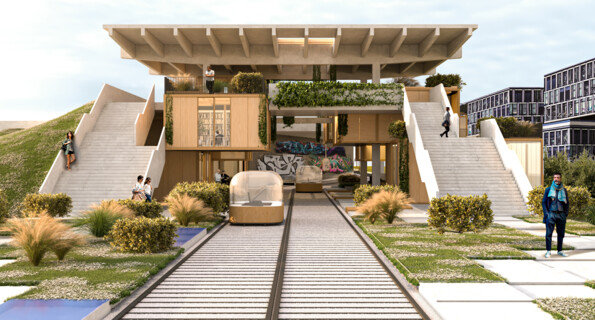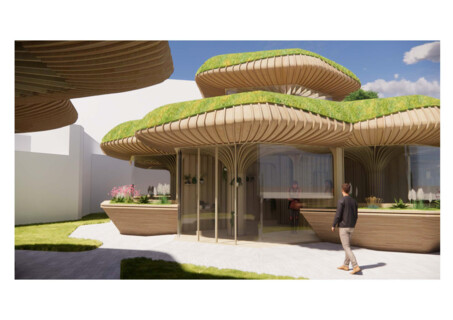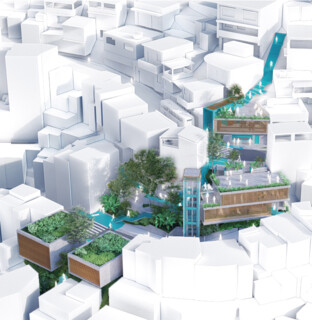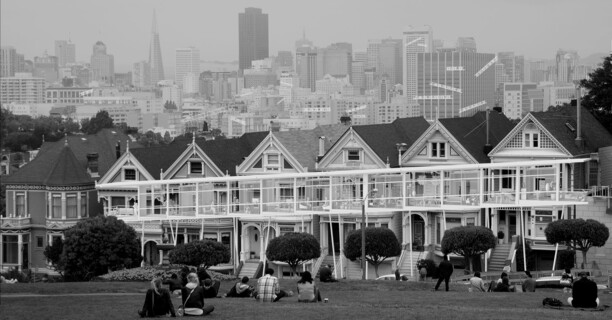- wa-ID
- wa-2031919
- Tag der Veröffentlichung
- 10.06.2021
- Aktualisiert am
- 25.04.2022
- Verfahrensart
- Offener Wettbewerb
- Zulassungsbereich
-
Andere
- Teilnehmer
- Keine Teilnahmebeschränkungen
- Auslober
-
Buildner Architecture Competitions
ARCHHIVE BOOKS - Bewerbungsschluss
- 05.11.2021
- Abgabetermin
- 10.12.2021
- Bekanntgabe
- 18.02.2022
Verfahrensart
Offener Ideenwettbewerb (auch für Studenten)
Wettbewerbsaufgabe
Der moderne Arbeitsplatz hat sich in den letzten Jahrzehnten stark weiterentwickelt, und die Einführung neuer Technologien und die Auswirkungen der Coronavirus-Pandemie werden die Art und Weise, wie wir arbeiten, in Zukunft noch stärker verändern.
In den 1970er-, 80er- und 90er-Jahren waren die Büros noch überwiegend für Einzelarbeit eingerichtet, mit Mitarbeitern in ihren eigenen Kabinen und Managern in ihren eigenen Büros. Und obwohl im Laufe der Zeit allmählich Technologien eingeführt wurden, um die Produktivität zu verbessern, erfolgte die geschäftliche Kommunikation immer noch überwiegend über traditionelle Festnetzanschlüsse oder persönlich, und alle Dokumente wurden in Papierform erstellt, gespeichert und weitergegeben. In den 70er Jahren wurde zwar in E-Mail, Textverarbeitungsprogramme und PCs investiert, doch wurden sie erst Jahrzehnte später allgegenwärtig. Und Mobiltelefone waren zwar seit den späten 80er Jahren für die Öffentlichkeit verfügbar, aber groß, teuer und bis zur Jahrtausendwende keine gängige Praxis.
Seit dem Jahr 2000 wird das Wohlbefinden am Arbeitsplatz immer mehr in den Mittelpunkt gerückt, wobei die meisten modernen Einrichtungen eher auf Zusammenarbeit als auf individuelles Arbeiten ausgerichtet sind. Neue Tools und Technologien haben die Art und Weise, wie wir arbeiten und kommunizieren, verändert, z. B. cloudbasierte Software, Videokonferenzen und sogar E-Mail und soziale Medien. Dies hat es vielen Menschen ermöglicht, überall zu arbeiten, und sie sind weniger abhängig von einem festen Büroraum.
Dies wurde während der Coronavirus-Pandemie nur allzu deutlich, als viele von uns weit mehr als je zuvor aus der Ferne arbeiten mussten. Es ist unwahrscheinlich, dass die Arbeitsplätze jemals wieder vollständig zur Normalität zurückkehren werden, aber der Bedarf an Büroräumen besteht aus einer Reihe von Gründen weiter. Soziale Interaktion mit Kollegen, effektivere Arbeitsmittel (Technologie, Möbel, Raum), persönliche Zusammenarbeit und Kundenbesprechungen, zum Beispiel. Wie können sich also Arbeitsplätze weiterentwickeln und anpassen, um eine Kombination aus persönlichem und virtuellem Arbeiten zu ermöglichen?
Die Office 2021 Design Challenge ist der erste Teil einer jährlichen Wettbewerbsreihe, bei der die Teilnehmer die Arbeitsumgebung erforschen sollen. Die Jury sucht nach Designprojekten, die die Architektur als Instrument nutzen, um das Wohlbefinden und die Produktivität der Mitarbeiter zu verbessern. Dieser Wettbewerb ist eine Gelegenheit, sich die neue Normalität des Arbeitsplatzes nach der COVID vorzustellen.
Der Office 2021 Design-Wettbewerb wird zusammen mit der Office 2021 Essay Challenge durchgeführt, bei der die Teilnehmer ihre Ideen und Überlegungen vertiefen können. Die Teilnehmer können entweder den Aufsatz- und den Design-Wettbewerb getrennt oder zusammen einreichen.
Competition assignment
The modern workplace has evolved a lot over the past few decades, and the introduction of new technologies and the impact of the Coronavirus pandemic is set to completely change how we work even more in the future.
Back in the 1970s, 80s and 90s, offices were still mostly set up for individual working, with staff set up in their own cubicles and managers in their own offices. And while over time, technology was slowly introduced to help improve productivity, most business communication was still carried out via traditional landlines or in person, and documents were all created, stored and shared as hard copies. Email, word processors and personal computers had all been invested in the 70s, but didn’t become ubiquitous until decades later. And mobile phones, while available to the public from the late 80s, were large, expensive and not standard practice until the new millennium.
Since 2000, there has been an increasing focus placed on being comfortable in the workplace, with most modern setups centered around collaboration rather than individual working. New tools and new technologies have transformed the way we work and communicate such cloud-based software, video conferencing, and even email and social media. This has made it possible for many people to work anywhere and have become less dependent on a fixed office space.
This was made all too clear during the Coronavirus pandemic, when many of us were required to work remotely far more than ever before. It’s unlikely that workplaces will fully return to normal ever again, but there is still a need for office space for a number of reasons. Social interaction with colleagues, more effective tools (technology, furniture, space), face-to-face collaboration and client meetings, for example. So how can workplaces evolve and adapt to help facilitate a combination of in-person and virtual working?
The Office 2021 Design Challenge is the first in an annual competition series in which participants are tasked with exploring the work environment. The jury will be looking for design projects that use architecture as a tool to improve a worker’s wellbeing as well as their productivity. This challenge is an opportunity to envision the new normal of the workplace post-COVID.
The Office 2021 Design Challenge will be run in tandem with the Office 2021 Essay Challenge in which participants can explore their ideas and thinking in more detail. Participants can enter either the essay and design competition separately or together.
Jury
David Kubik, a partner at NYC-based BKSK Architecture
Dr Juriaan van Meel, co-founder of BriefBuilder, an expert in the field of architectural briefing and workplace design, and co-author of multiple books, including Activity-Based Working Practice Guide (2020), and Workplaces Today (2015)
Simeon Siegel, partner at Turett Collaborative Architects, where he has managed workplace projects
Weitere Informationen zu den Gewinnern finden Sie unter /
More information about the winners can be found at:
architecturecompetitions.com/office2021/
Offener Ideenwettbewerb (auch für Studenten)
Wettbewerbsaufgabe
Der moderne Arbeitsplatz hat sich in den letzten Jahrzehnten stark weiterentwickelt, und die Einführung neuer Technologien und die Auswirkungen der Coronavirus-Pandemie werden die Art und Weise, wie wir arbeiten, in Zukunft noch stärker verändern.
In den 1970er-, 80er- und 90er-Jahren waren die Büros noch überwiegend für Einzelarbeit eingerichtet, mit Mitarbeitern in ihren eigenen Kabinen und Managern in ihren eigenen Büros. Und obwohl im Laufe der Zeit allmählich Technologien eingeführt wurden, um die Produktivität zu verbessern, erfolgte die geschäftliche Kommunikation immer noch überwiegend über traditionelle Festnetzanschlüsse oder persönlich, und alle Dokumente wurden in Papierform erstellt, gespeichert und weitergegeben. In den 70er Jahren wurde zwar in E-Mail, Textverarbeitungsprogramme und PCs investiert, doch wurden sie erst Jahrzehnte später allgegenwärtig. Und Mobiltelefone waren zwar seit den späten 80er Jahren für die Öffentlichkeit verfügbar, aber groß, teuer und bis zur Jahrtausendwende keine gängige Praxis.
Seit dem Jahr 2000 wird das Wohlbefinden am Arbeitsplatz immer mehr in den Mittelpunkt gerückt, wobei die meisten modernen Einrichtungen eher auf Zusammenarbeit als auf individuelles Arbeiten ausgerichtet sind. Neue Tools und Technologien haben die Art und Weise, wie wir arbeiten und kommunizieren, verändert, z. B. cloudbasierte Software, Videokonferenzen und sogar E-Mail und soziale Medien. Dies hat es vielen Menschen ermöglicht, überall zu arbeiten, und sie sind weniger abhängig von einem festen Büroraum.
Dies wurde während der Coronavirus-Pandemie nur allzu deutlich, als viele von uns weit mehr als je zuvor aus der Ferne arbeiten mussten. Es ist unwahrscheinlich, dass die Arbeitsplätze jemals wieder vollständig zur Normalität zurückkehren werden, aber der Bedarf an Büroräumen besteht aus einer Reihe von Gründen weiter. Soziale Interaktion mit Kollegen, effektivere Arbeitsmittel (Technologie, Möbel, Raum), persönliche Zusammenarbeit und Kundenbesprechungen, zum Beispiel. Wie können sich also Arbeitsplätze weiterentwickeln und anpassen, um eine Kombination aus persönlichem und virtuellem Arbeiten zu ermöglichen?
Die Office 2021 Design Challenge ist der erste Teil einer jährlichen Wettbewerbsreihe, bei der die Teilnehmer die Arbeitsumgebung erforschen sollen. Die Jury sucht nach Designprojekten, die die Architektur als Instrument nutzen, um das Wohlbefinden und die Produktivität der Mitarbeiter zu verbessern. Dieser Wettbewerb ist eine Gelegenheit, sich die neue Normalität des Arbeitsplatzes nach der COVID vorzustellen.
Der Office 2021 Design-Wettbewerb wird zusammen mit der Office 2021 Essay Challenge durchgeführt, bei der die Teilnehmer ihre Ideen und Überlegungen vertiefen können. Die Teilnehmer können entweder den Aufsatz- und den Design-Wettbewerb getrennt oder zusammen einreichen.
Competition assignment
The modern workplace has evolved a lot over the past few decades, and the introduction of new technologies and the impact of the Coronavirus pandemic is set to completely change how we work even more in the future.
Back in the 1970s, 80s and 90s, offices were still mostly set up for individual working, with staff set up in their own cubicles and managers in their own offices. And while over time, technology was slowly introduced to help improve productivity, most business communication was still carried out via traditional landlines or in person, and documents were all created, stored and shared as hard copies. Email, word processors and personal computers had all been invested in the 70s, but didn’t become ubiquitous until decades later. And mobile phones, while available to the public from the late 80s, were large, expensive and not standard practice until the new millennium.
Since 2000, there has been an increasing focus placed on being comfortable in the workplace, with most modern setups centered around collaboration rather than individual working. New tools and new technologies have transformed the way we work and communicate such cloud-based software, video conferencing, and even email and social media. This has made it possible for many people to work anywhere and have become less dependent on a fixed office space.
This was made all too clear during the Coronavirus pandemic, when many of us were required to work remotely far more than ever before. It’s unlikely that workplaces will fully return to normal ever again, but there is still a need for office space for a number of reasons. Social interaction with colleagues, more effective tools (technology, furniture, space), face-to-face collaboration and client meetings, for example. So how can workplaces evolve and adapt to help facilitate a combination of in-person and virtual working?
The Office 2021 Design Challenge is the first in an annual competition series in which participants are tasked with exploring the work environment. The jury will be looking for design projects that use architecture as a tool to improve a worker’s wellbeing as well as their productivity. This challenge is an opportunity to envision the new normal of the workplace post-COVID.
The Office 2021 Design Challenge will be run in tandem with the Office 2021 Essay Challenge in which participants can explore their ideas and thinking in more detail. Participants can enter either the essay and design competition separately or together.
Jury
David Kubik, a partner at NYC-based BKSK Architecture
Dr Juriaan van Meel, co-founder of BriefBuilder, an expert in the field of architectural briefing and workplace design, and co-author of multiple books, including Activity-Based Working Practice Guide (2020), and Workplaces Today (2015)
Simeon Siegel, partner at Turett Collaborative Architects, where he has managed workplace projects
Weitere Informationen zu den Gewinnern finden Sie unter /
More information about the winners can be found at:
architecturecompetitions.com/office2021/
OFFICE 2021 DESIGN CHALLENGE
Auslober
BEE BREEDERS Architecture Competition Organisers, Singapore (SG)
Wettbewerbsart
Offener Ideenwettbewerb (auch für Studenten)
Sprache
Englisch
Preissumme
6.000 EUR
Wettbewerbsaufgabe
The modern workplace has evolved a lot over the past few decades, and the introduction of new technologies and the impact of the Coronavirus pandemic is set to completely change how we work even more in the future.
Back in the 1970s, 80s and 90s, offices were still mostly set up for individual working, with staff set up in their own cubicles and managers in their own offices. And while over time, technology was slowly introduced to help improve productivity, most business communication was still carried out via traditional landlines or in person, and documents were all created, stored and shared as hard copies. Email, word processors and personal computers had all been invested in the 70s, but didn’t become ubiquitous until decades later. And mobile phones, while available to the public from the late 80s, were large, expensive and not standard practice until the new millennium.
Since 2000, there has been an increasing focus placed on being comfortable in the workplace, with most modern setups centered around collaboration rather than individual working. New tools and new technologies have transformed the way we work and communicate such cloud-based software, video conferencing, and even email and social media. This has made it possible for many people to work anywhere and have become less dependent on a fixed office space.
This was made all too clear during the Coronavirus pandemic, when many of us were required to work remotely far more than ever before. It’s unlikely that workplaces will fully return to normal ever again, but there is still a need for office space for a number of reasons. Social interaction with colleagues, more effective tools (technology, furniture, space), face-to-face collaboration and client meetings, for example. So how can workplaces evolve and adapt to help facilitate a combination of in-person and virtual working?
The Office 2021 Design Challenge is the first in an annual competition series in which participants are tasked with exploring the work environment. The jury will be looking for design projects that use architecture as a tool to improve a worker’s wellbeing as well as their productivity. This challenge is an opportunity to envision the new normal of the workplace post-COVID.
The Office 2021 Design Challenge will be run in tandem with the Office 2021 Essay Challenge in which participants can explore their ideas and thinking in more detail. Participants can enter either the essay and design competition separately or together.
Competition is open to all. No professional qualification is required. Design proposals can be developed individually or by teams (4 team members maximum). Correspondence with organizers must be conducted in English;
All information submitted by participants must be in English
Schedule
Closing date for registration
05 NOVEMBER, 2021
Closing date for project submission
10 DECEMBER, 2021 (11:59pm GMT+0)
Announcement of the winners
Informationen
architecturecompetitions.com/office2021/
Auslober
BEE BREEDERS Architecture Competition Organisers, Singapore (SG)
Wettbewerbsart
Offener Ideenwettbewerb (auch für Studenten)
Sprache
Englisch
Preissumme
6.000 EUR
Wettbewerbsaufgabe
The modern workplace has evolved a lot over the past few decades, and the introduction of new technologies and the impact of the Coronavirus pandemic is set to completely change how we work even more in the future.
Back in the 1970s, 80s and 90s, offices were still mostly set up for individual working, with staff set up in their own cubicles and managers in their own offices. And while over time, technology was slowly introduced to help improve productivity, most business communication was still carried out via traditional landlines or in person, and documents were all created, stored and shared as hard copies. Email, word processors and personal computers had all been invested in the 70s, but didn’t become ubiquitous until decades later. And mobile phones, while available to the public from the late 80s, were large, expensive and not standard practice until the new millennium.
Since 2000, there has been an increasing focus placed on being comfortable in the workplace, with most modern setups centered around collaboration rather than individual working. New tools and new technologies have transformed the way we work and communicate such cloud-based software, video conferencing, and even email and social media. This has made it possible for many people to work anywhere and have become less dependent on a fixed office space.
This was made all too clear during the Coronavirus pandemic, when many of us were required to work remotely far more than ever before. It’s unlikely that workplaces will fully return to normal ever again, but there is still a need for office space for a number of reasons. Social interaction with colleagues, more effective tools (technology, furniture, space), face-to-face collaboration and client meetings, for example. So how can workplaces evolve and adapt to help facilitate a combination of in-person and virtual working?
The Office 2021 Design Challenge is the first in an annual competition series in which participants are tasked with exploring the work environment. The jury will be looking for design projects that use architecture as a tool to improve a worker’s wellbeing as well as their productivity. This challenge is an opportunity to envision the new normal of the workplace post-COVID.
The Office 2021 Design Challenge will be run in tandem with the Office 2021 Essay Challenge in which participants can explore their ideas and thinking in more detail. Participants can enter either the essay and design competition separately or together.
Competition is open to all. No professional qualification is required. Design proposals can be developed individually or by teams (4 team members maximum). Correspondence with organizers must be conducted in English;
All information submitted by participants must be in English
Schedule
Closing date for registration
05 NOVEMBER, 2021
Closing date for project submission
10 DECEMBER, 2021 (11:59pm GMT+0)
Announcement of the winners
Informationen
architecturecompetitions.com/office2021/




















































